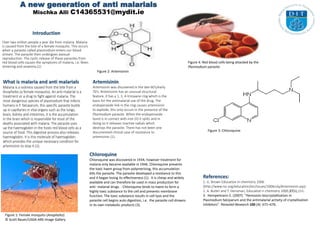poster
- 1. A new generation of anti malarials
Mischka Alli C14365531@mydit.ie
Introduction
Over two million people a year die from malaria. Malaria
is caused from the bite of a female mosquito. This occurs
when a parasite called plasmodium enters our blood
stream. The parasite then undergoes asexual
reproduction. The cyclic release of these parasites from
red blood cells causes the symptoms of malaria, i.e. fever,
shivering and anaemia.(1)
What is malaria and anti malarials
Malaria is a sickness caused from the bite from a
Anopheles (a female mosquito). An anti-malarial is a
treatment or a drug to fight against malaria. The
most dangerous species of plasmodium that infects
humans is P. falciparum, this specific parasite builds
up in capillaries in vital organs such as the lungs,
brain, kidney and intestines, it is the accumulation
in the brain which is responsible for most of the
deaths associated with malaria. The parasite uses
up the haemoglobin in the hosts red blood cells as a
source of food. This digestive process also releases
haemoglobin. It is this molecule of haemoglobin
which provides the unique necessary condition for
artemisinin to stop it (2).
Artemisinin
Artemisinin was discovered in the late 60’s/early
70’s. Artemisinin has an unusual structural
feature, it has a 1, 2, 4-triosxane ring which is the
basis for the antimalarial use of the drug. The
endoperoxide link in the ring causes artemisinin
to explode, this only occurs in the presence of the
Plasmodium parasite. When the endoperoxide
bond is in contact with iron (II) it splits and in
doing so it releases reactive radials which
destroys the parasite. There has not been one
documented clinical case of resistance to
artemisinin (1).
Chloroquine
Chloroquine was discovered in 1934, however treatment for
malaria only became available in 1946. Chloroquine prevents
the toxic haem group from polymerising, this accumulation
kills the parasite. The parasite developed a resistance to this
and it began losing its effectiveness (1). It is cheap and widely
available and can therefore be used in mass production for
anti- malarial drugs. . Chloroquine binds to haem to form a
highly toxic substance to the cell and prevents membrane
function. The toxic substance results in cell lysis and the
parasite cell begins auto digestion, i.e. the parasite cell drowns
in its own metabolic products (3).
References:
1. G. Brown Education in chemistry 2006
(http://www.rsc.org/education/eic/issues/2006July/Artemisinin.asp)
2. A. Butler and T. Hensman, Education n chemistry 2000,37(6),151.
3. Hempelmann E. (2007). "Hemozoin biocrystallization in
Plasmodium falciparum and the antimalarial activity of crystallization
inhibitors". Parasitol Research 100 (4): 671–676.
Figure 1: Female mosquito (Anopheles)
© Scott Bauer/USDA-ARS Image Gallery
Figure 2: Artemisinin
Figure 3: Chloroquine
Figure 4: Red blood cells being attacked by the
Plasmodium parasite
